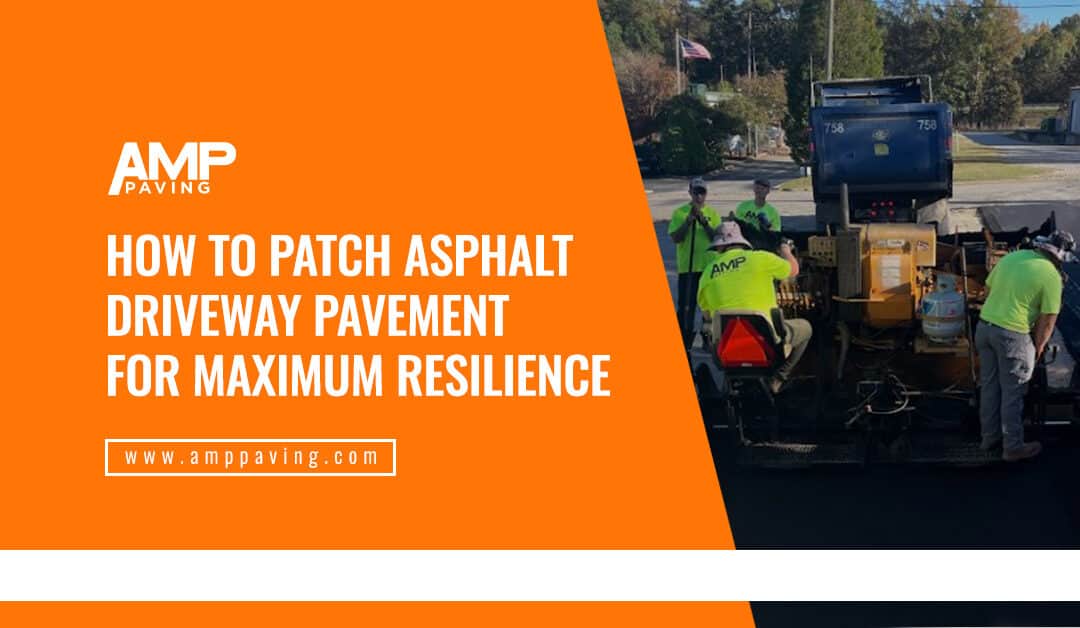When it comes to maintaining your driveway, ensuring that it stands up to the tests of weather and daily wear is crucial. One of the most effective ways to keep your existing asphalt resilient is by patching those bothersome cracks and holes. Our blog, “How to Patch Asphalt Driveway For Maximum Resilience,” will guide you through the necessary steps to restore your driveway to its former glory.
This easy-to-follow guide will provide insights and tips to transform your entire surface into pavement that looks great and lasts for years. Whether you want to take on the task yourself or understand what professionals do, this guide is your pathway to a smooth, durable driveway.
What is Asphalt Patching vs. Asphalt Filler?
When it comes to maintaining and repairing asphalt surfaces, understanding the difference between asphalt patching and asphalt filler is essential. While both serve the purpose of fixing cracks or holes in the pavement, they have different applications, properties, and use cases.
Asphalt Patching
Asphalt patching is the process of repairing larger, more severe cracks or potholes in the asphalt surface. It fixes substantial damages that go beyond mere surface imperfections.
Asphalt patching involves removing the damaged area, cleaning it, and filling it with a new asphalt mixture. This process might include using Hot Mix Asphalt (HMA) or cold patch products.
Asphalt patching is suitable for larger potholes or extensive cracking, where there is a significant compromise in the pavement’s integrity.
Patching usually requires more tools and preparation. It might involve cutting around the damaged area, removing loose materials, applying a tack coat for adhesion, and filling with the asphalt patch material.
Asphalt patching provides a more permanent solution, especially when using HMA, as it binds well with the existing pavement.
Asphalt Filler
Asphalt filler, or crack filler, is used to seal smaller cracks that do not threaten the overall integrity of the asphalt surface.
Asphalt filler is a liquid material containing asphalt emulsion, polymers, and other additives to provide flexibility and adhesion. It is poured into the crack and then smoothed over the surface.
Crack filler is ideal for smaller, non-structural cracks, such as hairline or superficial cracks that appear on the surface.
The process is relatively simple and may include cleaning the crack, applying the filler, and using a squeegee or other tool to level the surface.
While effective for small cracks, asphalt filler may not provide a long-term solution for larger, structural issues.
How to Choose?
In essence, asphalt patching is ideal for large, structural damages, offering a robust and permanent solution. However, asphalt filler is more suitable for minor, non-structural cracks, providing a temporary fix and helping to prevent further deterioration.
Choosing between asphalt patching and asphalt filler depends on the type and extent of the damage. Small cracks and superficial imperfections can often be handled with crack filler, while larger potholes and deep cracks will likely require the more substantial repair that asphalt patching provides.
Understanding the nature of the damage and using the appropriate repair method ensures a smooth, resilient surface for your driveways and business parking lots.
DIY Asphalt Patch vs. Professional Repair
When it comes to asphalt repair, you can take two main routes – a Do-It-Yourself approach using cold patch products, or hiring professional asphalt contractors who typically use Hot Mix Asphalt (HMA). Both methods have their advantages and are suitable for different situations.
Understanding the differences between DIY asphalt repair using cold patch products and professional asphalt repair using Hot Mix Asphalt (HMA) is essential for choosing the right solution for your driveways and business parking lots.
Cold Asphalt Patch Products for DIY Repair
Cold patch products, often called cold mix asphalt, are composed of a blend of asphalt aggregates and binding agents.
Ease of Use: These products are premixed and can be poured directly into the damaged area, then tamped down. According to Consumer Reports, cold patch products are “an easy, inexpensive way to fix potholes yourself” (Consumer Reports, 2020).
However, making repairs on your own means you need professional tools such as a plate compactor or tamping tool to fill the repaired area and make it even with the other asphalt.
Cost-Effective: Being available at most hardware stores, they are generally an economical choice for minor repairs. With many products, you simply pour the asphalt patching product into the asphalt pothole or crack.
Flexibility: They cure during air exposure, and you can apply them in various weather conditions.
Durability: While a quick solution, the binding is not as strong as HMA, so it may require more frequent maintenance. In addition, if your asphalt issues come from a below-surface problem, they will reappear and need repair again.
Hot Mix Asphalt for Professional Repair
Hot Mix Asphalt is a blend of aggregates like sand, stone, and asphalt cement heated to the right temperature.
Quality: HMA requires proper heating and professional application, creating a more permanent and stable repair. The National Asphalt Pavement Association says that “HMA offers the best compaction and adhesion to the surrounding existing surface” (NAPA, 2019).
Versatility: Whether a large business parking lot or a residential driveway, HMA provides a seamless and sturdy surface.
Efficiency: Professional contractors utilize specialized equipment to complete repairs quickly and ensure complete and lasting repairs. According to Asphalt Contractor Magazine, “properly maintained equipment is essential to the production of high-quality asphalt mixtures” (Asphalt Contractor Magazine, 2020).
Investment: While initially more costly, HMA repair provides longevity and may reduce long-term costs. The Federal Highway Administration notes that “HMA pavements have high durability, long life, and low maintenance costs” (Federal Highway Administration, 2017).
The choice between DIY repair using cold patch products and professional repair with Hot Mix Asphalt depends on various factors like the extent of damage, budget, and desired durability.
Cold patch products provide an accessible and economical solution for minor fixes, while professional HMA repairs ensure quality and lasting resilience. Referencing expert opinions and understanding the technical aspects of each method will guide you to the best solution for your specific needs.
Understanding Different Types of Asphalt Cracks and When to Seek Professional Help
Asphalt surfaces, whether driveways or business parking lots, can develop various types of cracks over time. Recognizing these cracks and knowing when to fix them yourself or call in professional help is crucial for maintaining a smooth and resilient surface. Let’s delve into the technical aspects of different types of cracks.
1. Hairline Cracks
These are very thin, superficial cracks that may look like a spiderweb on the surface.
Technical Description: Hairline cracks are usually less than 1/8-inch wide and don’t extend deep into the asphalt.
DIY or Professional?: Hairline cracks can often be treated with cold patch asphalt products available at hardware stores. A good cleaning and a simple application can sometimes prevent them from reoccurring. However, getting a professional sealer coat is crucial every 2-3 years to maintain your asphalt’s water protection factors.
2. Alligator Cracks
Named for their resemblance to alligator skin, these cracks indicate more significant issues.
Technical Description: Alligator cracks consist of many interconnecting cracks, creating small, irregular pieces. These usually suggest a failure in the sub-base or poor drainage.
DIY or Professional?: Due to their complexity, professional assessment and repair using HMA are typically recommended.
3. Longitudinal Cracks
These cracks run parallel to the centerline of the pavement or driveway.
Technical Description: Longitudinal cracks can vary in width and depth but usually result from asphalt shrinkage or issues with the joint between lanes or parking stalls.
DIY or Professional?: Smaller longitudinal cracks might be treated with a high-quality cold patch product, while larger, more pronounced ones may require professional attention.
4. Transverse Cracks
Transverse cracks run perpendicular to the centerline and may extend across the entire width of the pavement.
Technical Description: Often caused by temperature fluctuations, transverse cracks can vary significantly in width and depth.
DIY or Professional?: Narrow transverse cracks may be manageable with DIY methods, but wider cracks may benefit from professional repair with HMA.
5. Edge Cracks
These cracks appear along the edges of the pavement, often accompanied by crumbling asphalt.
Technical Description: Edge cracks usually result from poor drainage, heavy vegetation alongside the edges, or lack of support on the pavement edges.
DIY or Professional?: If caught early, edge cracks might be fixable with cold patch asphalt, but more extensive damage likely calls for professional repair.
Bottom Line: Deciding How to Repair
Understanding the nature and cause of various types of asphalt cracks can guide your decision on whether to undertake a DIY repair or seek professional help. Smaller, superficial cracks like hairline and some longitudinal or transverse ones might be suitable for DIY methods.
In contrast, alligator cracks and extensive edge or longitudinal cracks will likely require the expertise of professional asphalt contractors.
Staying vigilant and addressing cracks as they appear can prevent more significant problems down the road and help maintain the durability and appearance of your driveways and business parking lots. If in doubt, consulting with an experienced asphalt contractor can provide the necessary guidance and ensure a proper, long-lasting repair.
Our Experienced Asphalt Contractors Can Help
At AMP Paving, we understand the complexities of asphalt repair and maintenance. From identifying the right solution for minor cracks to handling extensive damages that require professional patching, our team is here to guide you through the process.
Equipped with state-of-the-art tools, extensive knowledge, and a commitment to quality, we can evaluate the condition of your driveway or business parking lot and recommend the most effective repair method, be it using asphalt patching or filler.
Don’t let those cracks and holes linger; reach out to our experienced asphalt contractors for a FREE quote!
Let us help you restore your asphalt surfaces to their former glory, ensuring durability, aesthetics, and long-lasting resilience. Your satisfaction is our priority, and we look forward to serving all your asphalt needs.

